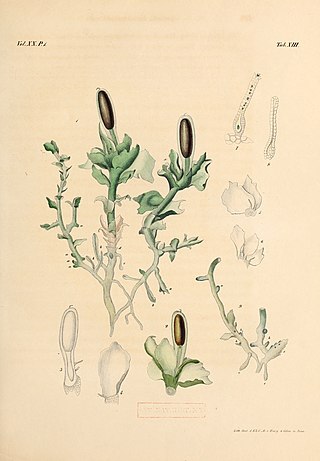
This article relates to the flora of New Zealand, especially indigenous strains. New Zealand's geographical isolation has meant the country has developed a unique variety of native flora. However, human migration has led to the importation of many other plants as well as widespread damage to the indigenous flora, especially after the advent of European colonisation, due to the combined efforts of farmers and specialised societies dedicated to importing European plants & animals.

The Marchantiophyta are a division of non-vascular land plants commonly referred to as hepatics or liverworts. Like mosses and hornworts, they have a gametophyte-dominant life cycle, in which cells of the plant carry only a single set of genetic information.

Lunularia cruciata, the crescent-cup liverwort, is a liverwort of the order Marchantiales, and the only species in the genus Lunularia and family Lunulariaceae. The name, from Latin luna, moon, refers to the moon-shaped gemma cups.

Lepidoziaceae is a family of leafy liverworts. It is a group of small plants that are widely distributed.
Bruce Alexander Fuhrer OAM was an Australian botanist and photographer, specialising in cryptogams. His photographic collection of fungi numbers more than 3000 species.
Bazzania bhutanica is a species of liverwort in the family Lepidoziaceae.

Bazzania is a genus of liverwort in the family Lepidoziaceae.
Herbertus borealis is a species of liverwort in the family Herbertaceae known as northern prongwort. It was described in 1970 by Alan Crundwell. It is endemic to Scotland, where it is found only in the Beinn Eighe nature reserve, and lives in dwarf shrub heath alongside other large liverworts such as Anastrophyllum donnianum, Bazzania tricrenata and Pleurozia purpurea. A closely related species, described in 2012 as Herbertus norenus and known as "Viking prongwort", is known from Shetland and Norway and was formerly confused with H. borealis.

Haplomitriopsida is a newly recognized class of liverworts comprising fifteen species in three genera. Recent cladistic analyses of nuclear, mitochondrial, and plastid gene sequences place this monophyletic group as the basal sister group to all other liverworts. The group thus provides a unique insight into the early evolution of liverworts in particular and of land plants in general.
The New Zealand Plant Conservation Network (NZPCN) is a non-governmental organisation devoted to the protection and restoration of New Zealand's indigenous plant life, including vascular plants, mosses, liverworts, hornworts and lichens.

Penn's Rocks is a 10.2-hectare (25-acre) biological Site of Special Scientific Interest north of Crowborough in East Sussex.

Perrottetinene is a naturally occurring cannabinoid compound found in liverworts from the genus Radula native to Japan, New Zealand and Costa Rica, namely Radula perrottetii, Radula marginata and Radula laxiramea, along with a number of similar compounds. Its chemical structure closely resembles that of THC, the main active component of marijuana but with a cis rather than trans conformation and a bibenzyl tailchain instead of pentyl. The absolute configuration of perrottetinene was established in 2008 by an enantioselective total synthesis.
Radula marginata, or Wairuakohu, is a species of plant in the genus Radula, a genus of liverworts. It is endemic to New Zealand. It has been found to contain cannabinoids.

Bazzania trilobata, the greater whipwort or threelobed bazzania, is a species of liverwort in the Lepidoziaceae family. It grows in the northern hemisphere temperate zone.

Dame Ella Orr Campbell was a New Zealand botanist. An expert on bryophytes, she published 130 scientific papers on liverworts, hornworts, orchids, and wetlands. She became the first woman faculty member of the Massey Agricultural College in 1945, and in 2003 the herbarium at Massey was renamed the Dame Ella Campbell Herbarium in her honour. Following her retirement from teaching in 1976, she continued to research and publish for another two decades, finally retiring in 2000 at the age of 90.

Pallavicinia lyellii, the ribbonwort or veilwort, is a dioicous bryophyte plant in the liverwort family Pallaviciniaceae. Often seen in moist situations on rocks and soil, with a worldwide distribution.
Sabatinca bimacula is a species of moth belonging to the family Micropterigidae. This species is endemic to New Zealand and has only been found in the Percy Valley and on Secretary Island in Fiordland. This species is sexually dimorphic with the male of the species having an 'L'-shaped marking on the forewing while in the female the 'L'-shaped marking is much broader and takes up most of the half of the forewing nearest the abdomen. The adults of this species are on the wing in the second half of October. Larvae of this species feed on the liverwort Bazzania involuta. The host species of adult S. bimacula are unknown but are likely to be fern spores or pollen from Sedge grasses. As at 2017 S. bimacula has been classified as having the "At Risk, Naturally Uncommon" conservation status under the New Zealand Threat Classification System.

The oil bodies of liverworts, occasionally dubbed “complex” for distinction, are unique organelles exclusive to the Marchantiophyta. They are markedly different from the oil bodies found in algae and other plants in that they are membrane-bound, and are not associated with food storage. The organelles are variable and present in an estimated 90% of liverwort species, often proving taxonomically relevant. As a whole, the formation and function of the organelles are poorly understood. Complex oil bodies are recognized as sites of isoprenoid biosynthesis and essential oil accumulation, and have been implicated with anti-herbivory, desiccation tolerance, and photo-protection.

Symphyogyna podophylla is a dendroid liverwort which is widespread in wet forests. It occurs in New Zealand, South America, Southern Africa, and is very common in wet forests of Australia and Tasmania.












